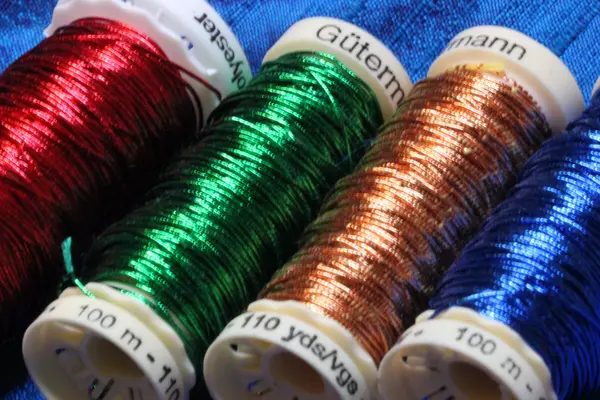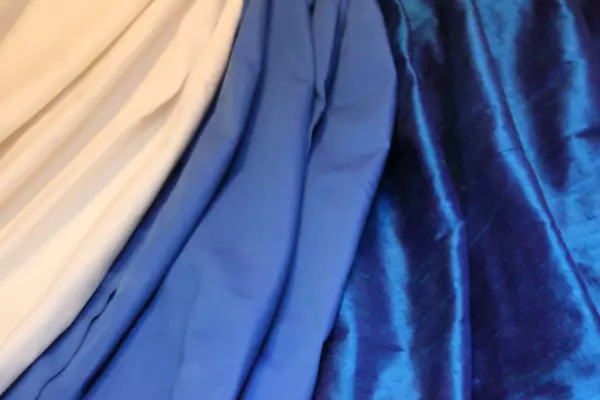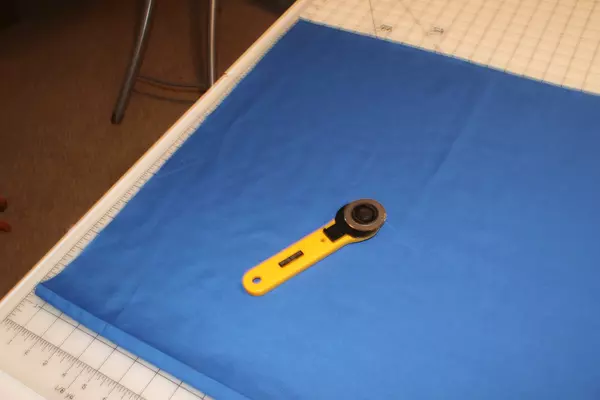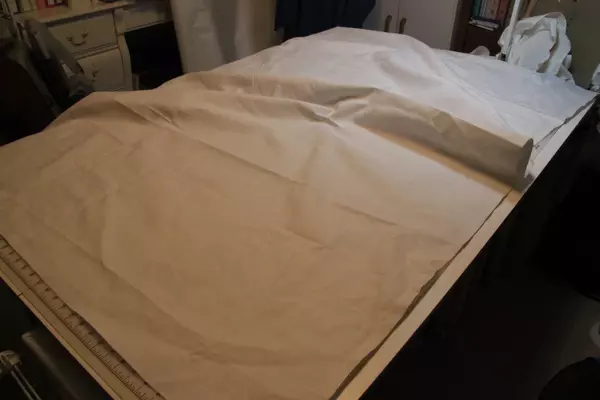Bits and Pieces Advent Set
Bits and Pieces Advent Set
Every evening after work, I try to accomplish something on various Ecclesiastical Sewing Projects. Sometimes, it is quite late before finishing other obligations of the day, and the enjoyment of sewing and hand embroidery can begin. When the clock ticks faster than normal and the evening speeds by with these late starts on projects, it is often difficult to sit down and tackle anything major. Rather than doing nothing, it is often a great time to tackle the bits and pieces advent set vestment sewing project.

An order arrived about a week or so ago with these lovely Passing Threads in colors. The threads came wound up in a little bundle as seen here. Last evening, while I was using the Red Passing thread, it became quite entangled as I unwound it from the little bundle, and it became very unruly to work with. There were tangles, twists, kinks, and curls. The unruly thread makes stitching impossible.

The worst part was that the kinks were starting to damage the thread. Something must be done to tame this mess! Luckily, for some reason, there was a bag of empty thread spools hanging around. It was the perfect answer. With a little patience and care, the wild passing threads soon regained their composure and were neatly wrapped on spools and replaced in their tiny zip-lock bags. No more kinks, no more tangles, just smooth stitching with these passing threads. These threads really look lovely when stitched. One little project was done while waiting for the kids’ homework to be handed over for a glance through. Hum – what else is there to do?

Underlining Fabrics for Altar Frontal Embroidery
The beautiful blue Silk Dupioni used for the Altar Frontal has already been cut to size. But the other pieces have yet to be cut. Before cutting the other fabrics, let’s go through the fabric choices and the reasons for their use. The Silk Dupioni is the face fabric, visible with the Ecclesiastical Embroidery designs worked and applied to it. The Silk Dupioni has a loose weave, and over time, the weight of the embroidery may cause the fabric to wear and shred too soon. What to do? Take a tip from Couture Sewing where Dupioni is often underlined. Years ago when making custom bridal gowns, I would always underline the silks, which means, cutting two layers of fabric, putting them together, and from that point going forward, treating them as one.
The top choices for underlining Silk Dupioni in the garment-making world are to use either Silk Organza or China Silk. Using silk organza or China Silk fabrics as underlings changes the hand of the Silk Dupioni. The folds become softer, richer, and hang more gracefully rather than being so crisp and hanging or sticking out. The use of either of these fabrics as an underlining in the chasuble and cope would be wonderful, but we will save those vestment pieces for a later conversation.
For an Altar frontal, there are no folds or drapes to the fabric unless it is a gathered or Laudian Frontal. So what works as an underlining for these pieces? For starters, using a fabric that does not shift as easily as Silk Organza would be an option. Cost is another minor factor, as is adding a body without adding bulk. The answer (I think and hope) is as simple as selecting a polyester/cotton blend broadcloth.
Broadcloth for Underlining

The broadcloth has a firm weave, yet is still lightweight. It will add body and firmness to the Silk Dupioni without adding bulk. It is not slippery and does not shift. So, two lengths of the broadcloth were cut and are ready to be applied to the Silk Dupioni for the Altar frontal. The fabrics will be basted together first, and then the seams will be sewn. I readily admit that this is not a step used by other vestment makers, but the use of the broadcloth underlining is a step I am adding to my project, based on years of working with these silks in the garment industry. It hopefully with work the way I envision, but time will tell.
Cotton Canvas

The next and final fabric that I planned to cut this evening was the easiest. Cotton Canvas is used as the interfacing fabric on the stole, pulpit fall, and altar frontal. The canvas will also be used as the “decking” that goes across the top of the altar and hangs down the back side of the altar. In looking through the closet, there was already one piece of canvas cut, squared, and ready to go. This piece had been prepared last spring. The cut piece is the correct size for the frontal interfacing. One additional piece of canvas will need to be cut for the decking.
Function
Cotton Canvas is a very heavy utility fabric that is used on the inside of church vestment pieces such as Altar Frontals, Pulpit falls, and stoles. It is tightly woven and adds needed body, support, structure, and weight so vestments hang correctly. Have you ever noticed a pastor’s stole where the ends just did not seem to want to hang straight and stay put – a stole that seems like the ends would up and fly away every time the pastor moved? Or an altar frontal that looked limp, as if a sheet were flung over the altar, with no body or support? The problem is a lack of the necessary weight and inside structure needed to maintain the shape and position of the vestment piece.
Cotton canvas is the answer to that issue. At one point in time, a linen fabric might have been used as the interfacings. But today, in the US, there is nothing readily available in a course, heavy linen for use as interfacings for vestments. Now, in other countries, there may be fabrics of similar weight and weave that goes by a different name that is suitable for these interfacings. Dowlas is a name often mentioned as an interfacing used in the UK.
The clock strikes and it is time to end the evening’s work. A few little things have been done to move projects forward. Maybe tomorrow will be an earlier start. Until then, happy stitching!
Solo Dei Gloria
Be sure to visit our online store front Ecclesiastical Sewing where you may shop for Liturgical Fabrics, altar linen fabrics, church vestment-making patterns, liturgical machine embroidery designs, church vestment trims and notions and so much more. You may also find us on Ecclesiastical Sewing on Facebook, Twitter, and Pinterest. Sign up for our mailing list at the bottom of the page on our online store front and receive a free copy of our Small Linens Booklet as our way of saying thank you for following along.
The First Pattern to go with Silk Dupioni: 5 inch stole
How to Make a Clergy Stole: Stole Making
4 1/2 Inch Wide Pastoral Stole Pattern
Silk Dupioni Liturgical Stole Kit with Evesham Orphrey
Rose Chasuble and Stole Vestments for Advent and Lent
How to Cut Orphrey Bands






 RSS - Posts
RSS - Posts
Informative post, as usual. My education in this continues. Thank you!